What is "pilgrimage"? Walk, eat, pray, sleep...let's go and meet your ``simple self'' on Kumano Kodo Iseji. First part
The Kumano Kodo is a pilgrimage route that reached its peak in the Edo period about 400 years ago, and is still visited by many people today. Why did people walk this difficult journey through the deep mountains, and what kind of feelings did they have? What exactly is a “modern pilgrimage”? This time, we will explore the essence and charm of Kumano Kodo Iseji while actually walking it.

Review again! What is Kumano Kodo?
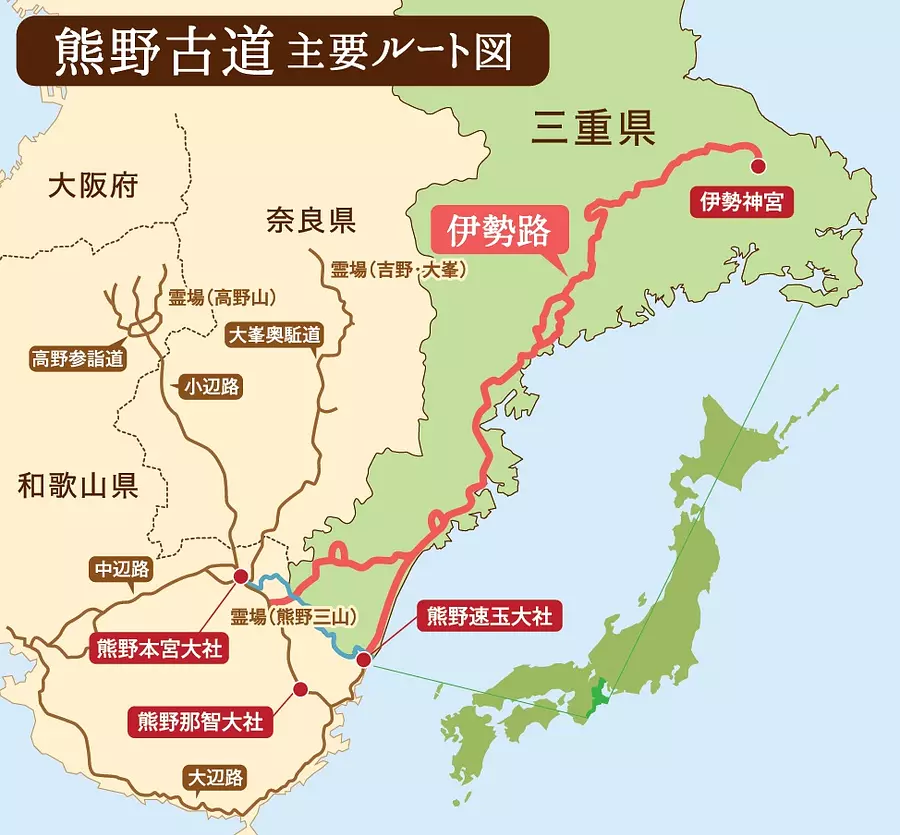
Kumano Kodo is a pilgrimage route that has been followed by our ancestors since ancient times.
It is a pilgrimage route that connects the three major shrines known as the Kumano Sanzan: Kumano Hongu Taisha, Kumano Hayatama Taisha, and Kumano Nachi Taisha.
Pilgrimage to these three mountains is called `` Kumano Pilgrimage''.
The sacred sites and pilgrimage routes of the Kii Mountains were registered as a UNESCO World Heritage Site in 2004. Kumano Kodo includes ``Iseji'', ``Nakahechi'', ``Kohechi'', ``Ohechi'', and ``Koya Sankeimichi''. There are six routes called ``Omine Okugakemichi.''
Walking along Iseji, which connects two sacred places
Among these, the 170km long Kumano Kodo Iseji is a road that connects Ise Grand IseJingu, which is the spiritual home of the Japanese people, and Kumano Sanzan, which is surrounded by deep mountains and is home to the gods and Buddha.
For people in the era when there were no cars or trains like we do today, visiting Ise Shrine or visiting Kumano was an aspirational journey that could only be done once in a lifetime, and it was also a life-threatening journey that was sometimes fraught with danger.
Many pilgrims have walked this path over hundreds of years of history.
What exactly did they see and feel while walking this Iseji route?
And what did you discover within yourself through the pilgrimage?
This time, I, Yuriko Tamaki, who is a writer and guide, and Mayumi Yamashita of the YouTube channel ``Adult Girls' Mountain Climbing'' will be among the travelers walking this trail. I would like to explore its essence and charm!
Yuriko Tamakiis a navigator and radio DJ from Gifu Prefecture. He is also a ``Common Pilgrimage Achiever'' who has walked both the Santiago Pilgrimage Route and the Kumano Kodo, and currently lives in Mihama Town, Mie MihamaTown, where the Kumano Kodo is located, and Nagoya.
Mayumi Yamashita isa model/talent who has been climbing for 10 years. Moved to Nagano Prefecture in 2019 and enjoys mountain climbing throughout the year. We are currently disseminating a wide range of information, including information about actual mountain climbing and introductions to mountain goods.
The journey begins with the sunrise from the torii gate of IseJingu.

Every year, one month before and after the winter solstice, you can watch the sunrise from between the large torii gates.
Now, let's start the journey.
The first place we visited Naiku IseJingu, where Amaterasu Omikami, Japan's guardian deity, is enshrined.
Pilgrims from Edo walked nearly 500km to reach IseJingu, and from there headed for Kumano.
I was happy to have arrived safely in Ise, and excited to head further into Kumano.
They must have been deeply moved as they stood here 400 years ago.
| name | IseJingu Naiku (Kotaijingu) |
|---|---|
| address | IseCity ujitachicho 1 |
| telephone number | 0596-24-1111 |
| Official URL | https://www.isejingu.or.jp/ |
| business hours |
[Visiting hours] ■October/November/December 5:00 a.m. to 5:00 p.m. ■January, February, March, April, September 5:00 a.m. to 6:00 p.m. ■May/June/July/August 5:00 a.m. to 7:00 p.m. |
| parking | Click here for details |
| Access by public transportation | [Naiku] 15 minutes by bus from Kintetsu "Ujiyamada Station" |
| Access by car | [Naiku] 5 minutes from Ise Expressway "Ise Nishi" or "Ise IC" |
Tamaru, the starting point for those aiming for the holy land of Kumano with a fresh mind

At the corner of the T-junction, there is a signpost engraved with ``Left Yoshino Kumanomichi.'' It is said to have been built during the Edo period.
If you cross the Miyagawa River from Naiku IseJingu through the Geku Shrine, you will arrive at the town of Tamaru in TamakiTown.
The pilgrims changed into white clothing and sugegasa hats, and headed for the sacred site of Kumano with a fresh mind.
The distance from Ise to Kumano is approximately 170km.
This time we will introduce some recommended spots that you can visit in 1 night and 2 days.
Let's follow the pilgrims of old and retrace their path from here in Tamaru.
The entrance to the profound Kii Mountains. The first mountain pass on the Iseji route, Oni Pass

The first mountain pass you come across after starting your walk from Tamaru is Mekitoge Pass.
The Kii Mountain Range, which we will be entering on our journey, is a profound world where many deep mountains overlap like folds of cloth.
As befits the entrance to such a world, the mountain pass has a quiet atmosphere.

Bamboo, cedar, and cypress forests spread out on both sides of the road, and from the top you can see the mountains of the Kii Mountain Range that you will soon enter.
This is a place that makes you feel like your journey to Kumano is finally starting.
| name | Oni Pass |
|---|---|
| address | Nonaka, TakiTown |
| telephone number | 0598-38-1117 (TakiTown Agriculture, Forestry and Commerce Division) |
| Access by car | 15 minutes by car from Ise Expressway Sewataki Interchange |
Takiharanomiya you can listen to the sounds of greenery, water, and nature.

35km from Tamaru town. After crossing Oni Pass and Misesaka Pass, you will reach Takiharanomiya.
This shrine is said to have been worshiped here before IseJingu Omikami arrived at what is now Ise Grand Shrine.
For travelers making pilgrimages along the Ise Route, it may have been a place to express gratitude for a safe journey so far and pray for safety in the future.

In the precincts surrounded by trees, there is a gigantic tree with a strangely twisted trunk called ``Thirshugi Sugi.''

There is a wash basin on the Tondogawa River that flows through the grounds, where you can wash your hands with the river water.
When I washed my hands in the crystal clear river, the coolness of the water felt very soothing against my flushed body.
When you take a deep breath, it's as if your heart is completely cleansed.
This is the moment when you can feel the richness of nature on Iseji.

"Thank you for guiding me this far safely. I hope you can continue your journey safely."
Did the pilgrims pray like that?
Let us also join hands.
Kotaijingu Betsugu Takiharanomiya
0598-86-2018
free
none
100台
Approximately 20 minutes walk from JR Takihara Station
Immediately get off at Mie Kotsu Nanki Express bus stop "Takiharanomiya"
About 10 minutes from Kisei Expressway “Omiya Odai IC” on R42 towards Owase.
Magose-togePass, where beautiful stone pavements created by nature and humans remain.

After leaving Takiharanomiya, there are many more mountain passes such as Kasaka Pass, TsuZurato-togePass, and hajikami Pass, and the Iseji Route goes deeper into the mountains.
Beyond that is Magose-togePass Pass.
Once you cross this pass, you can see the town of Owase and feel closer to the sacred place of Kumano.

Magose-togePass has one of the most beautiful stone pavements of the Kumano Kodo, and is still visited by many people today.
In the Kii Peninsula, where it rains a lot, we laid cobblestones made of natural stones as a way to protect roads from flooding.
Beautiful scenery has been created through the combination of nature and human activities over a long history.
Even the steps you take on the cobblestones add strength.

A haiku monument by Magose-togePass, a haiku poet with ties to this area, is located at Magose Pass.
Magose-togePass has many other attractions besides the stone pavement, such as the remains of a milestone left from the Edo period and giant cedar and cypress trees.
The place where the teahouse used to be is now a large space where you can take a relaxing break.
Magose-togePass (Kumano Kodo Iseji)
0597-89-6172
Please use the parking lot at Michi-no-eki Kaizan.
Click here for bus timetables (Google Maps) https://goo.gl/lKN8qQ
・About 30 minutes on foot from JR Kisei Main Line "Aiga Station"
・Approximately 10 minutes by bus from JR Kisei Main Line Owase Station to Washige bus stop
・Approximately 5 minutes by car from Kisei Expressway "Kaizan IC" via National Route 42
Tengukurayama, a training ground for Shugendo and overlooking the beautiful sea
Now, let's go a little off the Kumano Kodo and stop at a place with even better views.
Since ancient times, `` Tengura-san'' has been a place where mountain monks ran as a training ground for Shugendo.
The mountain trail continues from the side of the haiku monument Magose-togePass, and it takes about 30 minutes to reach the top.

``Tengu Rock'' is located at the top of Mt. Tengukurayama.
After climbing up a steep mountain path with continuous stairs, what you will see at the end is...the super gigantic "Tengu Rock"!
If you walk around this rock, you will soon reach the top of Mt. Tengukurayama.

The shrine of En no Gyoja still stands on the top of Mt. Tengukura, which has a deep history of mountain worship.
It is said that there was large-scale volcanic activity in the Kumano region nearly 15 million years ago.
The huge rocks that were formed at that time still remain in various parts of Kumano today, and are worshiped as objects of worship or as places of ascetic training.
You can also climb to the top of Tengu Rock using a thrilling ladder!

When you stand on the rock, you can see a spectacular panoramic view of the Owase townscape, the Kumano Sea, and Mt. Odaigahara, one of Japan's 100 Famous Mountains!
The view of the ocean and mountains stretching out into the distance is typical of Kumano, and makes you feel as if you have come to a faraway, different world.

We also recommend eating your lunch on a rock with a beautiful view.
` Michi-no-eki Kaizan'', located at the entrance on the north side of Magose-togePass, serves `` Sanma Sushi'', a local dish.
(Before climbing Magose-togePass, don't forget to not only shop at Michi-no-eki Kaizan but also take a restroom break.)
*For long-term parking during busy periods such as long holidays, please use the Choshi Riverbed parking lot.
The firm saury pickled in salt and vinegar is perfect for recovering from fatigue.
I can see that my body is happy after walking the steep climb!
Michi-no-eki "Kaizan"
0597-32-3553
9:00~17:00
None (New Year's Day only)
34台
20 minutes walk from JR "Aiga Station"
5 minutes on National Route 42 from Kisei Expressway “Kaizan IC”
Learn about history and relax in a hot spring. Take a break in Owase town.
Now, after crossing the mountain pass, we descended into the town of Owase.
There are two spots in Owase that you should definitely visit when walking along Iseji.
① Mie Prefectural Kumano Kodo Center

One of the highlights is the architecture that uses Owase cypress, a tree that has been famous since the Edo period.
The first one is the Mie Prefectural Kumano Kodo Center.
There is an exhibition in the building on the right that is free to enter, where you can learn about the history of the Kumano Kodo, as well as the culture and nature of the Kii Peninsula. There is also an information center in the building on the left, where you can get maps for walking the ancient path.
Mie Prefectural Kumano Kodo Center
0597-25-2666
free
9:00~17:00
December 31st and January 1st (may be closed due to other maintenance, etc.)
60台
Separately for 4 large buses
・From JR Owase Station, take the bus bound for Kii Matsumoto for about 10 minutes and get off at Kumano Kodo Center-mae.
・Approximately 2 hours from Matsusaka Station by Nanki Express Bus bound for Kumano Kodo Center
・About 10 minutes by car from Kisei Expressway "Owase Kita IC"
② Yumekodo Owase

Yumekodo Owase is a short walk from the Kumano Kodo Center. There is also a restaurant where you can sample locally sourced fish.
Another thing that is essential for traveling is a bath!
At Yumekodo Owase, you can enjoy a bath using deep ocean water from the Kumano Sea.
The soft-touch hot water is divided into lukewarm and hot bathtubs, and soaking in alternating baths will relieve your body's fatigue. This is a perfect spot to recover from fatigue after walking through the mountain pass.
Yumekodo Owase Yumekodo no Yu
0597-22-1124
[Yumekodo no Yu]
【weekdays】
・General: 700 yen
・Over 65 years old: 600 yen
・4 years old to elementary school student: 350 yen
・Children under 3 years old: Free
[Saturdays, Sundays, holidays, busy seasons]
・General: 750 yen
・Over 65 years old: 650 yen
・4 years old to elementary school student: 350 yen
・Children under 3 years old: Free
*From May 1, 2023
(Seafood Restaurant Isabaya) 11:00-14:00
(Hot bath facility) 10:00-21:30 (Reception ends at 21:00)
Open every day (maintenance closures may apply)
Free parking available
From JR Owase Station, take the bus bound for Kii Matsumoto, about 10 minutes, and get off at Kumano Kodo Center Mae.
Approximately 15 minutes from Owase Kita IC
Umiyado Nikijima, a relaxing inn where you can relieve your tiredness
Soaking in the bath completely healed my body.
Lastly, I would like to introduce some recommended accommodations along the Kumano Kodo Iseji Route.
Umiyado Nikijima is a private guesthouse located in KumanoCity.
From the town of Owase, you have to cross Mt. Yakiyama, Miki Pass, Ugo Pass, Sone Jirozaka, Tarozaka, and many other passes before finally reaching the village of Nigishima.
This town, which seems to be nestled in the arms of the mountains and the sea, must have been a place of relaxation for travelers who have been walking through the deep mountains.

The most appealing thing about this inn is the view overlooking the ocean from the balcony.
As you watch the sun set behind the mountains, you can fully enjoy the elegance of the port town as it approaches dusk.

The inside of the room is decorated in a Japanese style, making it a relaxing space.
Looking back on your day in such a space is one of the best parts of traveling.
Click here to make a reservation for Umiyado Nikijima
I'm grateful for the obvious. What is the charm of a pilgrimage trip?
This is the first part of the Kumano IseJingu journey, which started at Ise Jingu and ended at Owase and Nikijima, crossing numerous passes and deep mountains.
How was that.

Walk in nature.
Enjoy the blessings of the land.
I thank God for my journey and pray for a safe journey.
Relieve your fatigue at a warm inn.
Walk, eat, pray, sleep...
If you think about it, even though it's called a "pilgrimage," what we're doing is very simple.

Because of its simplicity, when I encounter the beauty of nature and the warmth of people, I feel grateful.
On the other hand, even when I encounter a difficult road, I can muster up the courage to face it.
Perhaps it is your own heart that you are confronting through them.
“You can face yourself with a simple mind.
That is the charm of modern pilgrimage!”
This time, I felt this way once again as I walked along the Kumano Kodo Iseji Route.
I would be happy if those who read this article to the end were able to understand even a little bit of its charm.
Next time, we will finally arrive at Kumano, the sacred place of resurrection! Continued in the second part.

In the next article, the second part, we will finally step into the sacred place of Kumano.
Why did people aim for Kumano? Why does Kumano continue to attract so many people?
I would like to explore the charm of Kumano Kodo Iseji through a continuous walking journey!
Related spots
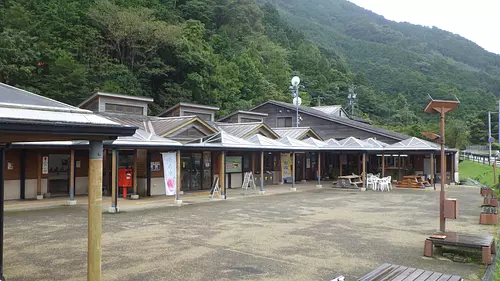
Michi-no-eki "Kaizan"
HigashiKishu
Kihoku Town, KihokuTownWe provide information on sightseeing spots in HigashiKishu and nature experiences at the sea, mountains, and rivers, and introduce and sell local specialties such as seafood and mountain products. In particular, we deliver hot information about the world heritage Kumano Kodo "Magose-togePass" and the clear Choshi River basin. Specialties: Sea mountain busse, Sanmata tsuta bowl, String set meal, Tuna bowl, Original mini dog, Tomato
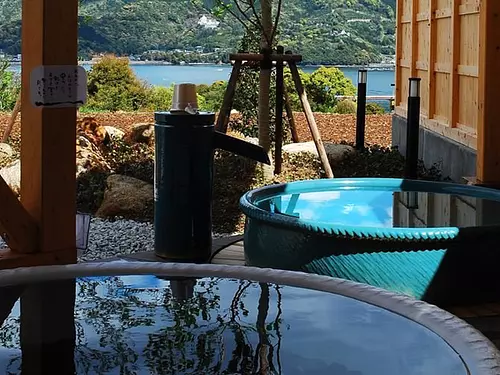
Yumekodo Owase Yumekodo no Yu
HigashiKishu
OwaseCityThe product building, which is a relocated 150-year-old traditional house, sells special products unique to Owase, and there is also a restaurant directly operated by a local seafood company where you can enjoy fresh seafood. At Yumekodo-no-Yu, a bath with deep ocean water that retains moisture and heat, you can take a bath while admiring the spectacular view of the world heritage Kumano Kodo Magose-togePass and Owase Bay.
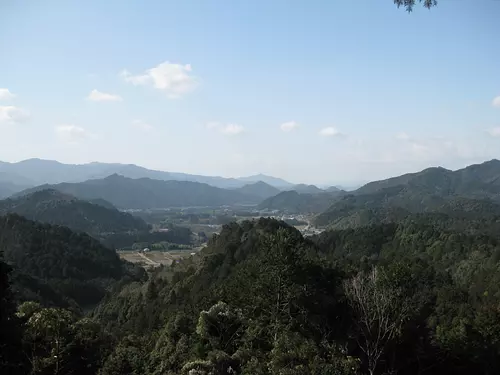
Oni Pass
Chunan group
Taki Town TakiTown<Autumn Oni-Toge Potato Digging Tour> First 60 participants! Please apply quickly ☆ 1. Date and time: Saturday, October 10, 2015 (Continues in light rain; postponed to the next day in case of heavy rain or other inclement weather) 2. Event time: 8:30-15:00 3. Meeting place: TakiTown GokatsuraLake Furusato Village 4. Sponsored by: Meki Pass Preservation Society (member of TakiTown Tourism Association) Supported by: Kumano Kodo Iseji Preservation Society, Miyagawa Basin Renaissance Council TakiTown 5. Participation fee: 1,300 yen for adults (lunch and insurance included), 300 yen for children (lunch and insurance included) *Up to 6th grade of elementary school <Overview> 8:30am - Reception begins 9:00am - Opening ceremony 9:10am - Walk starts 10 : 15:00 - Observation deck 11:00 - Potato digging 11:45 - Lunch (Ebisu River) 13:00 - Departure from the river 14:00 - Arrival at hometown village 14:30 - Dismissal <Participation award> I want you to dig potatoes, potatoes Kiko-chan strap, 200 yen worth of Furusatomura Grandma's store coupon <What to bring> Gloves, towel, hydration such as tea *Please prepare measures to prevent heat stroke. ☆ TakiTown Tourism Association's Facebook page is currently updating local information about TakiTown ☆ https://www.facebook.com/travel.taki ☆ TakiTown is also introduced on YouTube☆ https://www.youtube. com/watch?v=P4xho37W7Us <Meoni Pass> If you take the Kuma-no-Kaido road through the village of Narukawa and proceed past Tochigaike on your right, you will come to the first difficult place after coming from Ise, the Meoni Pass. During the Edo period, it was also called ``Neki Pass'' and ``Negi Pass.'' A stone Buddha statue of Nyoirin Kannon is enshrined on the south side of the mountaintop, and a monument with the name ``Namu Amidabutsu'' is erected nearby. The inscription "Genbun 3rd year (1738)" can be seen on the base stone of the stone Buddha. This old mountain pass road is too rough to pass from the Narukawa side, but as you climb up from okase, you can see that it retains its old condition well, with stone clusters and carved stone slabs.
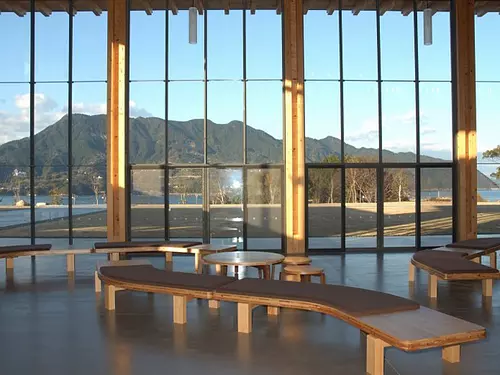
Mie Prefectural Kumano Kodo Center
HigashiKishu
OwaseCityThe Kumano Kodo Center is a visitor center that allows visitors to experience the Kumano Kodo and the surrounding area, nature, history and culture more deeply. We regularly hold experiential learning experiences that take advantage of the Kumano Kodo and its surrounding nature, including the mountains, ocean, and rivers, as well as lectures and lectures on the history and culture of the Kumano Kodo. It is a large wooden space with a more old-fashioned feel than ever before, built only from 135mm square solid Owase Hinoki wood.
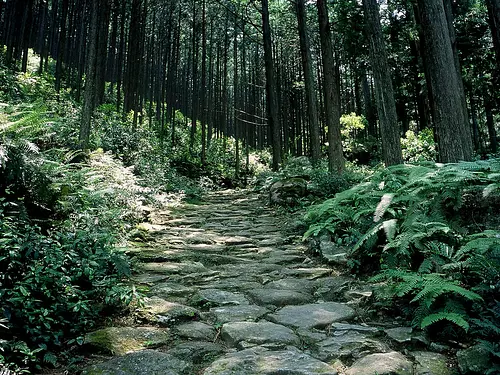
Magose-togePass (Kumano Kodo Iseji)
HigashiKishu
Kihoku Town, KihokuTownThe stone pavement, which is said to be the best on the Kumano Kodo Iseji, a popular mountain pass on the border of KihokuTown and OwaseCity, continues through a beautiful forest of Owase cypress trees. There are many historical sites such as the Night Cry Jizo that remain, and you can truly feel the atmosphere of the Kumano Kodo. From the pass, there are also hiking trails that lead to the peaks of Mt. Tengukura and Mt. Binishi, both of which offer spectacular views. Magoshi Park, located at the bottom of the mountain pass, is also a famous cherry blossom viewing spot, and is a popular spot visited by many people in spring. ○Course points: Michi-no-eki Kaizan - Night Cry Jizo - Ishibashi - Magoshi Ichirizuka - Karyoen Momotsu's Haiku Monument - Sakura Jizo - Magoshi Park - Owase Shrine, etc. ○Walking time: Approximately 2 hours and 30 minutes ○Distance: Approximately 5 km (Michi-no-eki Kaizan - JR Owase Station) ○Resting spots: Michi-no-eki Kaizan, Magose Park, Machikado Hot Center, etc. →For details, please see Magose-togePass Pass Course Walking Experience Report. URL: Magose-togePass (HigashiKishu Tourist Handbook) URL: Mie Prefectural Kumano Kodo Center [Magose-togePass] URL: First time walking the Kumano Kodo Iseji URL: World Heritage Kumano Kodo Iseji (Mie Prefectural Office HP) View this post on Instagram [Official] Post shared by Mie Tourism (Mie Prefecture Tourism Federation) (@kankomie) - May 17, 2019 11:32pm PDT




